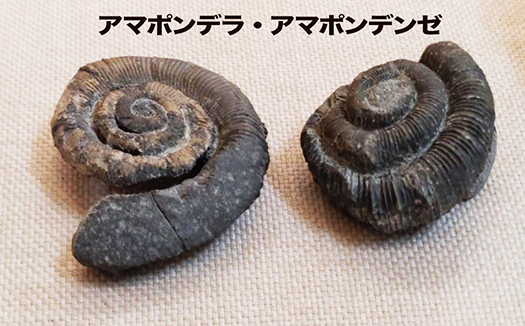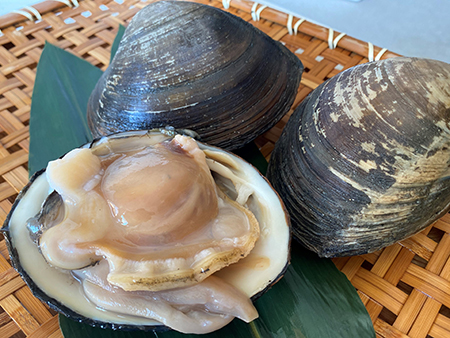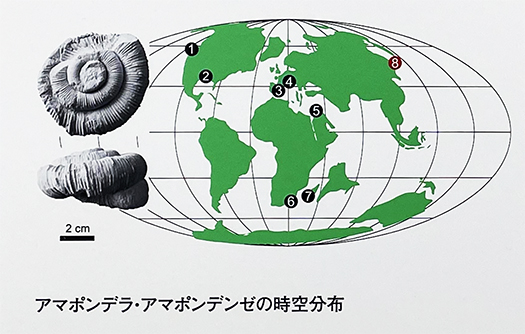

昨年末に東京上野の「科学博物館」で参観した「化学層序」の展覧会。歴史好きなので地層とか地質年代的にも興味を持っております。NHK「ブラタモリ」でも番組構成で下敷きにしていますね。地質学の基本となる情報は地層の積み重なりである「層序」という概念。層序は上位ほど新しく、各地層の厚さ、堆積構造、岩石や化石の種類の違いを示す。そういう概念を「化学層序」と呼ぶのだそうです。
そういえばと思い出すのが、不勉強極まりなかった高校時代。予習が通用しない学力テストがあって「地学」を選択したら、なんと学年トップランクの成績。個人的勉強史での唯一に近い「成功体験」(笑)。逆に考えるとそれ以来、地質は面白いと思ってこういう最新研究の成果発表に興味を持つのでしょうか。
そういうマニアックな展示会で学ぶことで来し方行く末のコンパス感覚が得られる。人間の歴史もそういう巨視スパンの基盤上に展開しているので強く影響されている。ふむふむと勉強させていただいていたら、突然目の前に「北海道」という文字が現れて思わず目が覚めてしまった。


「貝類」と言う生物種ととらえられる「アンモナイト」の一種「アマポンデラ・アマポンデンゼ」というイキモノは化石で確認される最新年代、約8020万年前には地球上で北海道でだけ発見されるのだそうです。
なんでもこの化石は北海道むかわ町穂別博物館から出張してこの東京の科学博物館に来ていたとのこと。WEBで検索しても、この生物種の情報はなかなか得られない。
一方アンモナイトは古生代シルル紀末期から中生代白亜紀末までのおよそ3億5000万年前後の間を、海洋に広く分布し繁栄した頭足類の分類群の一つ。多くの種が平らな巻き貝のような形をした殻を持っているのが特徴。・・・ということなので、やはり貝類との類縁性が強く感じられる。
普段から北海道の魚介類には深くお世話になっている。2枚目写真のホッキ貝などはそのうま味に魅せられて、ほぼ日常的に捌いて刺身として食している。そのはるかなご先祖さまが、思わぬ場面でいきなり降臨された気分。人間は罪深く、他の生物種を食べながら生き延びてきた。食べることはイキモノを殺すことだけれど、しかし同時にいのちの共生とも感じる。輪廻転生。・・・
English version⬇
Chemostratigraphy of Hokkaido’s “Shellfish” 80.2 Million Years Ago
While studying the latest research in geology, I encountered fossils of ancestors of Hokkaido shellfish. The history of the earth’s shellfish, which is made clear by the texture of sashimi. …
At the end of last year, I visited the “Chemistry Stratigraphy” exhibition at the Science Museum in Ueno, Tokyo. As a history buff, I am interested in geological stratigraphy and geochronology, and I know that NHK’s “Bratamori” also uses it as a basis for its program structure. The basic information of geology is the concept of “stratigraphy,” which is the layering of strata. The higher the stratigraphy, the newer it is, indicating differences in thickness, sedimentary structure, and types of rocks and fossils in each layer. Such a concept is called “chemostratigraphy.
This reminds me of my high school days when I was extremely ill-prepared. There was an achievement test that I could not prepare for, and I chose “geology,” and to my surprise, I was ranked in the top of my class. It was the only “success experience” in my personal study history (laughs). Thinking about it in reverse, I wonder if since then I have been interested in the presentation of the results of the latest research like this because I think geology is interesting.
Learning at such maniacal exhibitions gives me a sense of a compass for where we are going and where we are going to go. Human history is also strongly influenced by such a macroscopic span of time. As I was studying the exhibition, the word “Hokkaido” suddenly appeared in front of my eyes, and I was awakened unexpectedly.
Amapondera amapondense, a type of “ammonite” that is considered a “shellfish” species, is found only in Hokkaido on earth at the latest age confirmed by fossils, about 80.2 million years ago.
It is said that this fossil came to the Science Museum here in Tokyo on a business trip from the Hobetsu Museum in Mukawa-cho, Hokkaido, and that information on this species is not easy to find even when searching on the Web.
Ammonites, on the other hand, are a taxon of cephalopods that flourished and were widely distributed in the oceans from the late Silurian of the Paleozoic Era to the end of the Cretaceous of the Mesozoic Era, a period of about 350 million years. Many species are characterized by their flattened shells, which are shaped like a spiral shell. The species is strongly related to shellfish.
I have been deeply indebted to Hokkaido’s seafood, and am fascinated by the taste of hokki-gai clams, such as the one in the second photo, and eat them as sashimi almost on a daily basis. I feel as if these distant ancestors suddenly descended upon me at an unexpected moment. Humans have sinfully survived by eating other species. To eat is to kill a living thing, but at the same time, I feel that it is a symbiosis of life. Reincarnation. The reincarnation of life.
Posted on 3月 9th, 2023 by 三木 奎吾
Filed under: 歴史探訪







コメントを投稿
「※誹謗中傷や、悪意のある書き込み、営利目的などのコメントを防ぐために、投稿された全てのコメントは一時的に保留されますのでご了承ください。」
You must be logged in to post a comment.